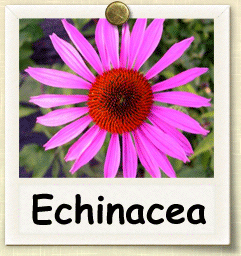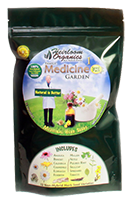|
Home > Guides > Herbs > Echinacea |
|
How to Grow Echinacea | Guide to Growing Echinacea |
|
|
|
|
| |
 |
|
Overview |
|
|
|
|
|
| |
|
| |
Echinacea has been used in North America for more than 400 years to treat infections and wounds, and as a general "cure-all." Today, people use Echinacea to shorten the duration of the common cold and flu and reduce symptoms, such as sore throat (pharyngitis), cough, and fever. Many herbalists also recommend echinacea to help boost the immune system and help the body fight infections. Echinacea is well known for its anti-viral, anti-bacterial, anti-fungal, and anti-inflammatory properties. |
|
| |
|
|
| |
|
|
| |
|
|
10-20 days (5-10 w/stratification) |
|
|
|
|
|
|
|
|
Alkaline, rich, rocky, well-drained |
|
|
|
|
|
|
|
|
|
|
|
|
Growing Guide
GROWING NOTES
Echinacea will begin to show the familiar large, purple coneflowers in late May or early July. It can grow to a height of around 4' and will attract bees and butterflies.
Echinacea prefers full sun to partial shade and well-drained, loamy or sandy soil that has some nutrient content and a slight alkalinity.
Echinaceae purpurea can be started in spring, or more ideally towards the end of the growing season in late summer or fall. Seeds are light dependant germinators so to get started, lightly tamp into soil or cover with a thin layer of soil (1/4" depth). If starting in early spring, your germination rate can be enhanced by placing flat of sown seeds outdoors for one week after the last freeze of the season has passed. This will help enhance germination rates.
MAINTAINING
Seeds can be placed indoors or inside a greenhouse to provide warmth needed for germination.
Once seeds have reached height of approximately 4" and show true leaves, they can be transplanted outdoors, spacing 8-12" apart between plants.
|
|
| |
|
| |
Heirloom seeds are the gardeners choice for seed-saving from year-to-year. Learning to save seeds is easy and fun with these books. Before you harvest, consider which varieties you might want to save seeds from so that your harvesting practice includes plants chosen for seed saving. Be sure to check out our newest seed packs, available now from Heirloom Organics. The Super Food Garden is the most nutrient dense garden you can build and everything you need is right here in one pack. The Genesis Garden s a very popular Bible Garden collection. The Three Sisters Garden was the first example of companion planting in Native American culture. See all of our brand-new seed pack offerings in our store.
|
|
| |
|
|
| |
Harvesting Guide
HARVESTING
Leaves, flowers, stems and seeds can be cultivated near the end of the first season. Be careful not to over-harvest any one plant, and be certain to give your plants adequate time to regenerate new growth between collections. Roots take more time and effort, as much as 3 or 4 years of growth or more to produce a sizable taproot, and should be collected in the spring or fall when the plant has gone to seed.
SAVING SEEDS
|
|
| |
|
|
|
| |
|
|
|
|
|
| You can find this variety in the following Seed Packs: |
|
  |
|
| Click the packs below to see some of our other wonderful products |
|
|
|
|
|
|
|